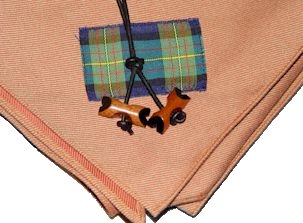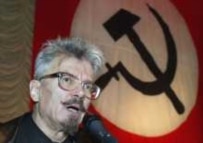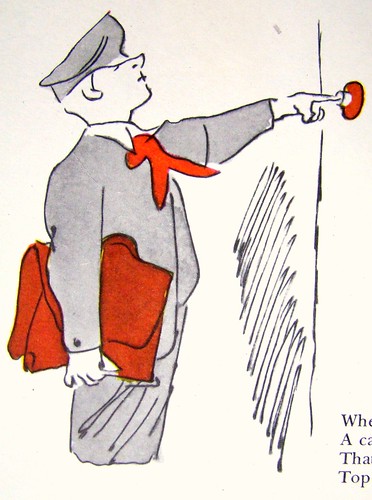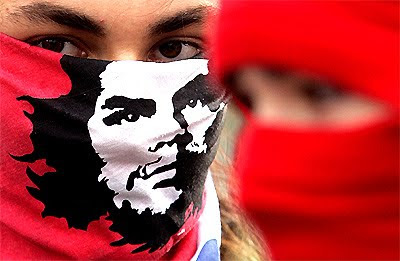No, not the last post, really. The Bandanas!-Blog has moved to a new page, under a new name: www.no-tie.blogspot.com.
Hope to see you there soon!
Thursday, September 16, 2010
Still seeing Red in Stavropol in 2010

A boy wearing a red neckerchief, the symbol of the young Pioneer organization, smiles in front of a monument to Soviet state founder Vladimir Lenin during the inauguration ceremony of newly adopted members of the movement on the day of its anniversary in Russia's southern city of Stavropol May 19, 2010.
Extract of this article in the C.S. Monitor
Monday, September 13, 2010
Becoming a Jungmaedel
From the 1940 Youth Leadership pamphlet for new members of the Jungmaedel, "The Jungmaedel Service":
The neckerchief and leather knot are always worn with your blouse. The neckerchief is a black triangle that is folded until only a small corner of about three fingers shows from underneath the collar in the back. Your leader will teach you how to fold the neckerchief. The leather knot is natural brown in color. It's used to hold the neckerchief.

Friday, September 10, 2010
Anarchist Neckerchief through this Blog!
Various schools within the anarchist movement have adopted their own flags, colours and neckerchiefs. These flags are bisected diagonally with the right half in black for anarchy and the left half in a color representing each school's ideas. These color templates are also extended to five-pointed stars representing the same schools.
The red-and-black flag is the symbol of the anarcho-syndicalist and anarcho-communist movements. Black is the traditional color of anarchism, and red is the traditional color of socialism. The red-and-black flag combines the two colors in equal parts, with a simple diagonal split. Typically, the red section is placed on the top-left corner, with the black on the bottom-right corner of the flag. This symbolizes the co-existence of anarchist and socialist ideals within the anarcho-syndicalism movement, and to symbolize the more socialistic means of the movement leading to a more anarchistic end.
The colours became best known during the Spanish Civil War, with members of the CNT and other anarchist movements adopted them for their flags, neckerchiefs and hats. Some beautiful pictures of the use of this neckerchief can be seen in the movie Libertarias, a must-see for anyone interested in the Spanish Civil War, Anarchism and the history of Socialism and Communism.
Now available through this site:
Large size triangular neckerchief in Black and Red
100% Cotton
Dimensions: 115cm (45") x 81cm (32")
Red Youth
No, the following article on www.MosNews.com is not from the pre-1990's Soviet Union, but this year's May. They are still around, the Red Youth with their trademark neckers.
The head of Russia Moscow
 Vladimir Zyuganov told the youngsters that donning the movement's trademark red neckerchief signified they had "taken on the responsibility of fulfilling the best traditions of our great Soviet nation."
Vladimir Zyuganov told the youngsters that donning the movement's trademark red neckerchief signified they had "taken on the responsibility of fulfilling the best traditions of our great Soviet nation.""I congratulate you, thank you for this responsible step, and hope that you will, with honor, declare your loyalty to the red banner," Zyuganov said.
The new Pioneers responded by chanting movement slogans, laying flowers in honor of Lenin and posing for photos with Zyuganov.
Tuesday, September 7, 2010
Subcomandante Marcos

Subcomandante Marcos (Date of birth unknown), is the spokesperson for the Zapatista Army of National Liberation (EZLN), a Mexican rebel movement. In January 1994, he led an army of Mayan farmers into the eastern parts of the Mexican state of Chiapas in protest of the Mexican government's treatment of indigenous peoples.
Marcos is an author, political poet, adroit humorist, and outspoken opponent of capitalism. Marcos has advocated having the Mexican constitution amended to recognize the rights of the country's indigenous inhabitants. The internationally known guerrillero has been described as a "new" and "postmodern" Che Guevara.
The nom de guerre "Marcos" is the name of a friend killed at a military road checkpoint. He is known as Delegado Cero (Delegate Zero) in matters concerning the Other Campaign. He is only seen wearing a balaclava, a bandana around his neck and a pipe in his mouth.
His true identity remains unknown.
Saturday, September 4, 2010
Ché Guevara
A blog on bandanas may not be the best possible forum to discuss politics, but it does amaze me time and time again how people adore this symbol of rebellion and revolution; not the under privileged, but very much the wealthy, hip and chic (that are so much what Ché fought against).

Yes, Ché was in many ways an admirable man, a tireless revolutionary with great ideas and a much needed initiator of social reform, but at the same time he was, and became more and more so, a totalitarian, a murderer, the founder of Cuba's notorious labor camps, a strict censor of writing and music and head of a firing squad – eliminating his political enemies.
A member of Red Youth Vanguard leftist political party with his face wrapped in a bandana sporting a portrait of Ernesto "Che" Guevara, takes part in a 2004 rally in Moscow. Hundreds of protesters gathered to mark the anniversary of the 'pro-communist coup d'etat of 1993'.
Much has been written, sung and filmed about Ché, pro and contra and even more can be found on the web.
One interesting article on the commercialization of Ché's image can be found here; and more specifically on the famous photo that adorns bandanas, upper arms & breasts, baseball caps, knickers, toilet paper and bikini briefs.
Wednesday, September 1, 2010
Carabinieri
Such a universal piece of material... Not only worn by activists, anarchists, cowboys and bank robbers, but also as a piece of uniform of the Italian Carabinieri.
And quite a nice one, it is. For those of you interested in wearing part of a police outfit, they can be ordered here.
And a more decorative version in silk for female officers:

And quite a nice one, it is. For those of you interested in wearing part of a police outfit, they can be ordered here.
And a more decorative version in silk for female officers:

Sunday, August 29, 2010
Bikers and Scarfs
There is something about bikers that gets them to wear aesthetically attractive and practical gear; berets, for example, and neckerchiefs.
They vary from fashionable - carrying the brand name or picture of their bike or associative designs to practical (protective, warm, guard for dust, mossies and other flying objects). Anyone who had the pleasure of a fly flying into his/her mouth at 120 km/h knows what I mean. 
Personally, i quite like this silk Harley Davidson scarf.

Personally, i quite like this silk Harley Davidson scarf.
Thursday, August 26, 2010
Scouting
A variety of Japanese Scouts Scarfs (or Neckers)
The Scouting movement makes the neckerchief part of its uniform. A generally ceremonial item, the neckerchief is taught to be a practical wilderness item in the Scouting tradition. The neckerchief, unrolled, is designed to be the perfect size for use as a triangular bandage for first aid.
In most countries each Scout Troop uses its own colour neckerchief. The colours are usually the "Troop Colours" which may have a particular historical significance to the troop or to the local community.
In Canada, while most groups use colour neckerchiefs, there is also an optional alternate universal pattern tartan neckerchief: white plaid on red for Scouts, gold plaid on dark green for Cubs. Alternating thick and thin lines of the plaid spell out "CANADA" in Morse code.
Slide (or toggle) with room for "survival materials"
In other countries individual patrols are identifiable by their neckerchiefs and so troops may have many different neckerchiefs all at once. In both of these cases the neckerchief and its colours are an issue of identity, and become emblematic of a troop or a patrol.In Australia, Queensland uses a single maroon scarf for the whole state, while the other states allow groups, Venturer Units and Rover Crews to choose their own scarf. Region and Branch Teams also have their own scarves. Neckerchiefs can also have important ceremonial functions in Scouting, for example, the 1st Gilwell Scout Group present a special neckerchief on completion of the Wood Badge.
Neckerchiefs can also have important ceremonial functions in Scouting, for example, the 1st Gilwell Scout Group present a special neckerchief on completion of the Wood Badge.Monday, August 23, 2010
The National Bolshevik Party
The National Bolshevik Party (NBP, Russian: Национал-большевистская партия, НБП, also known as Nazbol) is a Russian political party dedicated to the ideology of National Bolshevism. The NBP is a prominent member of The Other Russia coalition of opposition parties. There are also smaller NBP groups in other countries.
In Russia, the organization has been banned, and has never been officially registered as political party. Since being banned, it has seen somewhat of a decline in membership. The NBP's preferred political activity has consisted of direct action stunts, mostly against prominent political figures.
The organization's official organ is the journal Limonka (Лимонка). The name is a play of words on Limonov and is idiomatic Russian for grenade. It was forced to change its name after the authorities banned it for "promoting extremism and hatred".
As their name suggests, the party stands for a mix of National Socialist and Bolshevik politics, clearly emphasized by the Nazi inspired sleeve-band and logo. The party seems to be dominated by schoolchildren and young girls with lots of piercings and neckerchiefs worn in a variety of ways, judging by the photos on the party's web site.
The National Bolshevik Party advocates the creation of a Russian-dominated empire that would include all of Europe, as well as northern and central Asia. The party is vehemently opposed to American foreign policy, and believes that a Eurasian empire would be an essential counterbalance to capitalist global domination. However, when Aleksandr Dugin left the NBP to create his own party called Eurasia, the NBP lessened the emphasis on a geo-political agenda in favor of a national one, concentrating on the defence of Russian minorities in the former Soviet Union republics, and on opposition to the political regime in Russia.
The party has replaced its aggressive Eurasianist and imperialist nationalism with a Russian territorial nationalism. It has criticized Lithuania and Estonia for degrading Russian-Soviet World War II veterans and memorials, and for legislation that banned Soviet symbols such as the hammer and sickle and the red star, which placed them on par with the swastika and other Nazi imagery.

Eduard Limonov at an NBP rally
Friday, August 20, 2010
Italian Fascists

Not the prettiest part of neckerchiefs & bandanas, I know, but still part of the neckerchief-history. Better to get it over and done with: Fascist Youth of Italy, this time.
Researching on their uniforms, I find it hard to see any consistency: blue, green and black neckerchiefs appear on different pictures (if any of you can shed a light on this, please comment!).
What I do find consistent, is the kind of innocence of the children portrayed; probably not on purpose, but hopefully for many children it was, innocence.
Tuesday, August 17, 2010
Nazi's too...
Bund Deutschen Madel jacket from the Rhineland section of Germany
Unfortunately, not only the righteous on the political spectrum chose to wear neckerchiefs. The red and red/black neckerchief may have been one of the symbols of the Republican side during the Spanish Civil War, at the same time the Italian fascists and German Nazi's adopted their own scarfs as part of their uniforms.
Hitler Jugend Tunic With Neck Scarf, Whistle, and Streifendienst Sleeve-band
Interesting that many present-day anarchists, often finding their inspiration in the punk movement of the 1980's, choose to wear a solid black neckerchief as well...
Subscribe to:
Posts (Atom)






































